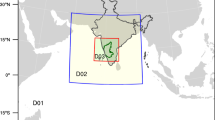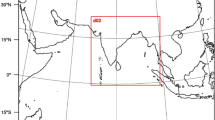Abstract
This study develops a proper way to incorporate Atmospheric Infrared Sounder (AIRS) ozone data into the bogus data assimilation (BDA) initialization scheme for improving hurricane prediction. First, the observation operator at some model levels with the highest correlation coefficients is established to assimilate AIRS ozone data based on the correlation between total column ozone and potential vorticity (PV) ranging from 400 to 50 hPa level. Second, AIRS ozone data act as an augmentation to a BDA procedure using a four-dimensional variational (4D-Var) data assimilation system. Case studies of several hurricanes are performed to demonstrate the effectiveness of the bogus and ozone data assimilation (BODA) scheme. The statistical result indicates that assimilating AIRS ozone data at 4, 5, or 6 model levels can produce a significant improvement in hurricane track and intensity prediction, with reasonable computation time for the hurricane initialization. Moreover, a detailed analysis of how BODA scheme affects hurricane prediction is conducted for Hurricane Earl (2010). It is found that the new scheme developed in this study generates significant adjustments in the initial conditions (ICs) from the lower levels to the upper levels, compared with the BDA scheme. With the BODA scheme, hurricane development is found to be much more sensitive to the number of ozone data assimilation levels. In particular, the experiment with the assimilation of AIRS ozone data at proper number of model levels shows great capabilities in reproducing the intensity and intensity changes of Hurricane Earl, as well as improve the track prediction. These results suggest that AIRS ozone data convey valuable meteorological information in the upper troposphere, which can be assimilated into a numerical model to improve hurricane initialization when the low-level bogus data are included.















Similar content being viewed by others
References
Allen DR, Hoppel KW, Nedoluha GE et al (2013) Limitations of wind extraction from 4D-Var assimilation of ozone. Atmos Chem Phys 13:3501–3515
Amerault C, Zou X (2003) Preliminary steps in assimilating SSM/I brightness temperatures in a hurricane prediction scheme. J Atmos Oceanic Technol 20:1154–1169
Aumann HH, Chahine MT, Gautier C et al (2003) AIRS/AMSU/HSB on the Aqua mission: design, science objectives, data products, and processing systems. IEEE Trans Geosci Remote Sens 41:253–264
Balis D, Isaksen ISA, Zerefos C et al (2011) Observed and modelled record ozone decline over the Arctic during winter/spring 2011. Geophys Res Lett 38:L23801. doi:10.1029/2011GL049259
Bian J, Gettelman A, Chen H et al (2007) Validation of satellite ozone profile retrievals using Beijing ozonesonde data. J Geophys Res 112:D06305. doi:10.1029/2006JD007502
Bosart LF (2003) Tropopause folding, upper-level frontogenesis, and beyond. Meteor Monogr 31:13–47
Carsey TP, Willoughby HE (2005) Ozone measurements from eyewall transects of two Atlantic tropical cyclones. Mon Wea Rev 133:166–174
Danielsen EF (1968) Stratospheric-tropospheric exchange based on radio-activity, ozone, and potential vorticity. J Atmos Sci 25:502–518
Davis C, Low NS, Shapiro MA et al (1999) Direct retrieval of wind from Total Ozone Mapping Spectrometer (TOMS) data: Examples from FASTEX. Quart J Roy Meteor Soc 125:3375–3391
Dethof A, Holm EV (2004) Ozone assimilation in the ERA-40 reanalysis project. Quart J Roy Meteor Soc 130:2851–2872
Durnford D, Gyakum J, Atallah E (2009) The conversion of total column ozone data to numerical weather prediction model initializing fields, with simulations of the 24–25 January 2000 East Coast snowstorm. Mon Wea Rev 137:161–188
El Serafy GY, Kelder HM (2003) Near-real-time approach to assimilation of satellite-retrieved 3D ozone fields in a global model using a simplified Kalman filter. Quart J Roy Meteor Soc 129:3099–3120
Eskes HJ, Piters AJM, Levelt PF et al (1999) Variational assimilation of GOME total-column ozone satellite data in a 2D latitude-longitude tracer-transport model. J Atmos Sci 56:3560–3572
Eskes HJ, Van Velthoven PFJ, Kelder HM (2002) Global ozone forecasting based on ERS-2 GOME observations. Atmos Chem Phys 2:271–278
Eskes HJ, Van Velthoven PFJ, Valks PJM et al (2003) Assimilation of GOME total-ozone satellite observations in a three-dimensional tracer-transport model. Quart J Roy Meteor Soc 129:1663–1681
Feng L, Brugge R, Hólm EV et al (2008) Four-dimensional variational assimilation of ozone profiles from the Microwave Limb Sounder on the Aura satellite. J Geophys Res 113:D15S07. doi:10.1029/2007JD009121
Fujita T (1952) Pressure distribution within a typhoon. Geophys Mag 23:437–451
Grell GA, Dudhia J, Stauffer DR (1994) A description of the fifth-generation Penn State/NCAR Mesoscale Model (MM5). NCAR Tech. Note NCAR/TN-398 + STR, National Center for Atmospheric Research, Boulder, CO, pp 138
Hao N, Koukouli ME, Inness A et al (2014) GOME-2 total ozone columns from MetOp-A/MetOp-B and assimilation in the MACC system. Atmos Meas Tech 7:2937–2951
Jang KI, Zou X, De Pondeca M et al (2003) Incorporating TOMS ozone measurements into the prediction of the Washington, DC, winter storm during 24–25 January 2000. J Appl Meteor 42:797–812
Kiesewetter G, Sinnhuber BM, Vountas M et al (2010) A long-term stratospheric ozone data set from assimilation of satellite observations: High-latitude ozone anomalies. J Geophys Res 115:D10307. doi:10.1029/2009JD013362
Levelt PF, Allaart MAF, Kelder HM (1996) On the assimilation of total-ozone satellite data. Ann Geophysicae 14:1111–1118
Liu Y, Zou X (2015) Impact of 4DVAR assimilation of AIRS total column ozone observations on the simulation of Hurricane Earl. J Meteor Res 29:257–271
Marshall JL, Uccellini L, Einaudi F et al (2007) The joint center for satellite data assimilation. Bull Amer Meteor Soc 88:329–340
Massart S, Clerbaux C, Cariolle D et al (2009) First steps towards the assimilation of IASI ozone data into the MOCAGE-PALM system. Atmos Chem Phys 9:5073–5091
Migliorini S, Brugge R, O’Neill A et al (2008) Evaluation of ozone total column measurements by the Ozone Monitoring Instrument using a data assimilation system. J Geophys Res 113:D15S21. doi:10.1029/2007JD008779
Migliorini S, Dragani R, Kaiser-Weiss AK et al (2009) The GlobMODEL demonstrator: assimilation of new satellite products in an operational meteorological center. IEEE J Sel Topics Appl Earth Observ 2:213–224
Monahan KP, Pan LL, McDonald AJ et al (2007) Validation of AIRS v4 ozone profiles in the UTLS using ozonesondes from Lauder, NZ and Boulder, USA. J Geophys Res 112:D17304. doi:10.1029/2006JD008181
Nakamura T, Akiyoshi H, Deushi M et al (2013) A multimodel comparison of stratospheric ozone data assimilation based on an ensemble Kalman filter approach. J Geophys Res 118:3848–3868
Normand C (1953) Atmospheric ozone and the upper-air conditions. Quart J Roy Meteor Soc 79:39–50
Ohring G, Muench HS (1960) Relationships between ozone and meteorological parameters in the lower stratosphere. J Atmos Sci 17:195–206
Pan LL, Bowman KP, Shapiro M et al (2007) Chemical behavior of the tropopause observed during the stratosphere-troposphere analyses of regional transport experiment. J Geophys Res 112:D18110. doi:10.1029/2007JD008645
Park K, Zou X (2004) Toward developing an objective 4DVAR BDA scheme for hurricane initialization based on TPC observed parameters. Mon Wea Rev 132:2054–2069
Penn S (1965) Ozone and temperature structure in a hurricane. J Appl Meteor 4:212–216
Pierce RB, Schaack T, Al-Saadi JA et al (2007) Chemical data assimilation estimates of continental U.S. ozone and nitrogen budgets during the Intercontinental Chemical Transport Experiment-North America. J Geophys Res 112:D12S21. doi:10.1029/2006JD007722
Pittman JV, Pan LL, Wei JC et al (2009) Evaluation of AIRS, IASI, and OMI ozone profile retrievals in the extratropical tropopause region using in situ aircraft measurements. J Geophys Res 114:D24109. doi:10.1029/2009JD012493
Pu Z-X, Tao W-K, Braun S et al (2002) The impact of TRMM data on mesoscale numerical simulation of Supertyphoon Paka. Mon Wea Rev 130:2448–2458
Remsberg E, Natarajan M, Fairlie TD et al (2013) On the inclusion of Limb Infrared Monitor of the Stratosphere version 6 ozone in a data assimilation system. J Geophys Res 118:7982–8000
Riishøjgaard LP (1996) On four-dimensional variational assimilation of ozone data in weather-prediction models. Quart J Roy Meteor Soc 122:1545–1571
Riishøjgaard LP, Källén E (1997) On the correlation between ozone and potential vorticity for large-scale Rossby waves. J Geophys Res 102:8793–8804
Rodgers EB, Stout J, Steranka J et al (1990) Tropical cyclone-upper atmospheric interaction as inferred from satellite total ozone observations. J Appl Meteor 29:934–954
Rösevall JD, Murtagh DP, Urban J et al (2008) A study of ozone depletion in the 2004/2005 Arctic winter based on data from Odin/SMR and Aura/MLS. J Geophys Res 113:D13301. doi:10.1029/2007JD009560
Saha S, Moorthi S, Pan H et al (2010) NCEP Climate Forecast System Reanalysis (CFSR) 6-hourly Products, January 1979 to December 2010. Res Data Archive Nat Center Atmos Res Comp Inform Syst Lab. doi:10.5065/D69K487J
Segers AJ, Eskes HJ, Van Der A et al (2005) Assimilation of GOME ozone profiles and a global chemistry-transport model using a Kalman filter with anisotropic covariance. Quart J Roy Meteor Soc 131:477–502
Shapiro MA, Krueger AJ, Kennedy PJ (1982) Nowcasting the position and intensity of jet streams using a satellite-borne total ozone mapping spectrometer, Nowcasting. Academic Press, San Diego, pp 137–145
Stajner I, Winslow N, Rood RB et al (2004) Monitoring of observation errors in the assimilation of satellite ozone data. J Geophys Res 109:D06309. doi:10.1029/2003JD004118
Stout J, Rodgers EB (1992) Nimbus-7 total ozone observations of western North Pacific tropical cyclones. J Appl Meteor 31:758–783
Struthers H, Brugge R, Lahoz WA et al (2002) Assimilation of ozone profiles and total column measurements into a global general circulation model. J Geophys Res 107:ACH 10-1–ACH 10-14
Wang H, Zou X, Li G (2012) An improved quality control for AIRS total column ozone observations within and around hurricanes. J Atmos Oceanic Technol 29:417–432
Wang Y, Wang B, Fei J et al (2013) The effects of assimilating satellite brightness temperature and bogus data on the simulation of Typhoon Kalmaegi (2008). J Meteor Res 27:415–434
Wargan K, Pawson S, Stajner I et al (2010) Spatial structure of assimilated ozone in the upper troposphere and lower stratosphere. J Geophys Res 115:D24316. doi:10.1029/2010JD013941
Wu LG, Wang B (2000) A potential vorticity tendency diagnostic approach for tropical cyclone motion. Mon Wea Rev 128:1899–1911
Wu Y, Zou X (2008) Numerical test of a simple approach for using TOMS total ozone data in hurricane environment. Quart J Roy Meteor Soc 134:1397–1408
Xiao Q, Zou X, Wang B (2000) Initialization and simulation of a landfalling hurricane using a variational bogus data assimilation scheme. Mon Wea Rev 128:2252–2269
Xiao Q, Chen L, Zhang X (2009) Evaluations of BDA scheme using the Advanced Research WRF (ARW) model. J Appl Meteor Climatol 48:680–689
Zhang X, Xiao Q, Fitzpatrick PJ (2007) The impact of multisatellite data on the initialization and simulation of Hurricane Lili’s (2002) rapid weakening phase. Mon Wea Rev 135:526–548
Zhao Y, Wang B, Ji Z et al (2005) Improved track forecasting of a typhoon reaching landfall from four-dimensional variational data assimilation of AMSU-A retrieved data. J Geophys Res 110:D14101. doi:10.1029/2004JD005267
Zhao Y, Wang B, Wang Y (2007) Initialization and simulation of a landfalling typhoon using a variational bogus mapped data assimilation (BMDA). Meteor Atmos Phys 98:269–282
Zou X, Wu Y (2005) On the relationship between Total Ozone Mapping Spectrometer (TOMS) ozone and hurricanes. J Geophys Res 110:D06109. doi:10.1029/2004JD005019
Zou X, Xiao Q (2000) Studies on the initialization and simulation of a mature hurricane using a variational bogus data assimilation scheme. J Atmos Sci 57:836–860
Zou X, Vandenberghe F, Pondeca M et al (1997) Introduction to adjoint techniques and the MM5 adjoint modeling system. NCAR Tech. Note NCAR/TN-435—STR, National Center for Atmospheric Research, Boulder. pp 110
Zou X, Xiao Q, Lipton AE et al (2001) A numerical study of the effect of GOES sounder cloud-cleared brightness temperatures on the prediction of Hurricane Felix. J Appl Meteor 40:34–55
Acknowledgments
This work was supported by the Beijige Fund of Jiangsu Institute of Meteorological Sciences (BJG201512), the Key Scientific Research Projects of Jiangsu Provincial Meteorological Bureau (KZ201605), the National Natural Science Foundation of China (41201045), and the Research Innovation Program for College Graduates of Jiangsu Province (CXZZ13_0506). The authors are grateful to Dr. Xiaolei Zou (Florida State University) for her support on this research. The comments from the anonymous reviewers are also appreciated.
Author information
Authors and Affiliations
Corresponding author
Additional information
Responsible Editor: X.-Y. Huang.
Rights and permissions
About this article
Cite this article
Liu, Y., Zhang, W. Improved hurricane forecasting from a variational bogus and ozone data assimilation (BODA) scheme: case study. Meteorol Atmos Phys 128, 715–732 (2016). https://doi.org/10.1007/s00703-016-0460-2
Received:
Accepted:
Published:
Issue Date:
DOI: https://doi.org/10.1007/s00703-016-0460-2




